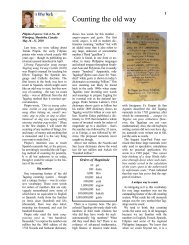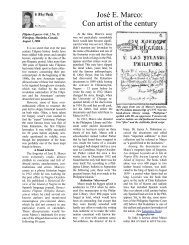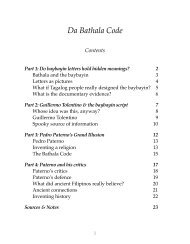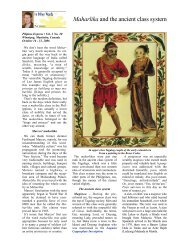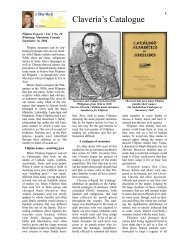071101 Chabacano.pdf - Pilipino Express
071101 Chabacano.pdf - Pilipino Express
071101 Chabacano.pdf - Pilipino Express
Create successful ePaper yourself
Turn your PDF publications into a flip-book with our unique Google optimized e-Paper software.
<strong>Chabacano</strong><br />
<strong>Pilipino</strong> <strong>Express</strong> • Vol. 3 No. 21<br />
Winnipeg, Manitoba, Canada<br />
November 1, 2007<br />
Like many stories about<br />
ordinary Filipinos during the early<br />
colonial era, the history of the<br />
<strong>Chabacano</strong> language is underresearched.<br />
The Spaniards studied<br />
many Philippine languages but<br />
they were not very interested in<br />
the heavily Spanish-influenced<br />
language that emerged during their<br />
occupation of the country. The few<br />
accounts that mentioned <strong>Chabacano</strong><br />
usually dismissed it as<br />
merely “broken” or “bad Spanish”<br />
and that attitude persists to this<br />
day. The word <strong>Chabacano</strong> itself is<br />
a Spanish word that means vulgar,<br />
common or rude and because of<br />
this, some <strong>Chabacano</strong> speakers<br />
prefer to spell the word as<br />
Chavacano or they refer to the<br />
language according to where it is<br />
spoken; calling it Zamboangueño,<br />
Caviteño, Ternateño, etc.<br />
Linguists began proper studies<br />
of the various dialects of <strong>Chabacano</strong><br />
in the last century but the<br />
dearth of historical records has<br />
made studying their origins rather<br />
difficult. This has left the door<br />
open for many wannabe historians<br />
to confuse matters with several<br />
conflicting folk tales.<br />
<strong>Chabacano</strong> in Cavite<br />
The various dialects of <strong>Chabacano</strong><br />
were formed out of necessity,<br />
like all languages, though scholars<br />
and laypersons disagree about<br />
exactly when and where it all<br />
began. Most believe that the seeds<br />
of the earliest form of <strong>Chabacano</strong><br />
were planted in Cavite when many<br />
ethnic groups from throughout the<br />
Philippines and Christian Malays<br />
from Ternate in the Spice Islands<br />
(now a part of Indonesia) were<br />
brought together in 1574 to help<br />
defend Manila against an expected<br />
attack from the forces of the<br />
Chinese pirate, Limahong. The<br />
various language groups working at<br />
the Cavite naval base needed a way<br />
to communicate with each other and<br />
with the soldiers who were barking<br />
the orders in less-than-genteel<br />
Spanish. It was from this situation<br />
that <strong>Chabacano</strong> began as a simplified<br />
form of Spanish – a pidgin<br />
language that later developed into a<br />
mixed, or creole language. The fact<br />
that the first <strong>Chabacano</strong>s learned<br />
their Spanish from the coarse<br />
language of soldiers is probably<br />
why they were called <strong>Chabacano</strong>s in<br />
the first place and why speakers of<br />
“proper Spanish” never regarded<br />
them as equals.<br />
However, some historians<br />
disagree with parts of this story and<br />
say that <strong>Chabacano</strong> did not emerge<br />
until almost a century later when<br />
Catholic Malays settled in Cavite<br />
after the Spaniards had abandoned<br />
the Spice Islands to the Dutch in<br />
1662. These Malays, known as the<br />
Mardicas (likely from the Malay<br />
word merdeka, meaning “free”),<br />
settled in the town that now shares the<br />
name of their original homeland,<br />
Ternate. They joined with many other<br />
language groups to defend Manila<br />
from yet another Chinese warlord,<br />
Koxinga (Zheng Chenggong).<br />
<strong>Chabacano</strong> in Zamboanga<br />
Today, <strong>Chabacano</strong> speakers are<br />
a small minority in Ternate, Cavite<br />
and Cavite City, and their numbers<br />
are dwindling. Another dialect of<br />
<strong>Chabacano</strong> that was once spoken<br />
in the Ermita district of Manila is<br />
now extinct. However, in Zamboanga<br />
City, about half the<br />
population of almost 600,000 still<br />
speak their own dialect of the<br />
language. Zamboangueño can be<br />
heard on television and radio, and<br />
read in newspapers and magazines.<br />
It is also spoken outside the city,<br />
throughout the lower half of the<br />
Zamboanga Peninsula and in<br />
places on the nearby island of<br />
Basilan. There are also dialects of<br />
<strong>Chabacano</strong> in Cotobato and<br />
Davao, though the Davao dialect<br />
has almost disappeared.<br />
The origin story of Zamboangueño<br />
follows the same pattern<br />
as <strong>Chabacano</strong> in Cavite and it is<br />
just as debatable. Some popular<br />
histories mark the origin of this<br />
<strong>Chabacano</strong> dialect with an exact<br />
date – June 23, 1635 – as though the<br />
language was created spontaneously<br />
overnight. That was the date when<br />
the Spaniards established Fort San<br />
Jose at the current location of<br />
Zamboanga City. It also had a<br />
polyglot complement of workers<br />
who received their orders from<br />
Mexican and Spanish soldiers.<br />
However, Spain held Fort San<br />
Jose for only 27 years. In 1662, its<br />
soldiers were called back to Cavite<br />
as part of the general consolidation<br />
of forces that was needed to defend<br />
Manila against Koxinga. The<br />
Spaniards abandoned the fort to<br />
their Muslim rivals until they could<br />
return in 1719 to rebuild it and<br />
rename it Fort Pilar.<br />
Major areas where <strong>Chabacano</strong> is spoken – from chabacano.iespana.es
Paul Morrow • In Other Words • The <strong>Pilipino</strong> <strong>Express</strong> • November 1, 2007<br />
2<br />
During the reconstruction,<br />
masons from Cavite, including<br />
<strong>Chabacano</strong>s, were brought to<br />
the fort to work with migrant<br />
labourers from Cebu, Iloilo<br />
and some of the local ethnic<br />
groups such as the Samals,<br />
Subanons and possibly, some<br />
escaped Muslim slaves. Just as<br />
in Cavite in the previous century,<br />
these various language<br />
groups needed to communicate<br />
with each other and with their<br />
Spanish and Mexican bosses.<br />
Eventually, the most successful<br />
dialect of <strong>Chabacano</strong> was<br />
developed – Zamboangueño.<br />
What is <strong>Chabacano</strong><br />
<strong>Chabacano</strong> is what linguists<br />
call a creole, which is a language<br />
that is formed when two or more<br />
languages have been mixed together.<br />
<strong>Chabacano</strong> has a predominantly<br />
Spanish vocabulary<br />
but its grammatical structures are<br />
based on local languages. For<br />
example, like all other Philippine<br />
languages, it does not follow the<br />
gender rules of Spanish. The<br />
masculine el (for the) is often<br />
used where the feminine la<br />
should be used, though la does<br />
exist in <strong>Chabacano</strong>. The plural<br />
forms, los and las are usually<br />
expressed with the neutral Tagalog<br />
particle mga, which is often<br />
pronounced maga or mana. In<br />
the case of Zamboangueño,<br />
plural personal pronouns such as<br />
kame, kita, kamo, sila and other<br />
basic words are taken from<br />
Cebuano rather than Spanish.<br />
The chart below contains translations<br />
of the Lord’s Prayer,<br />
which show just some of the<br />
differences between Spanish<br />
and three major dialects of<br />
<strong>Chabacano</strong>.<br />
E-mail the author at<br />
pilipinoexpress@shaw.ca or visit<br />
www.mts.net/~pmorrow<br />
The Lord’s Prayer in Spanish and three major dialects of <strong>Chabacano</strong> – from Wikipedia<br />
Spanish<br />
Zamboangueño<br />
Padre nuestro que estás en el Cielo,<br />
santificado sea tu nombre,<br />
venga a nosotros tu Reino,<br />
hágase tu voluntad<br />
en la Tierra<br />
como en el Cielo.<br />
Danos hoy nuestro pan de cada día,<br />
y perdona nuestras ofensas,<br />
como también nosotros perdonamos<br />
a los que nos ofenden,<br />
no nos dejes caer en la tentación,<br />
y líbranos del mal.<br />
Tata de amon talli na cielo,<br />
bendito el de Uste nombre.<br />
Manda vene con el de Uste reino;<br />
Hace el de Uste voluntad<br />
aqui na tierra,<br />
igual como alli na cielo.<br />
Dale kanamon el pan para cada dia.<br />
Perdona el de amon maga culpa,<br />
como ta perdona kame con aquellos<br />
quien tiene culpa kanamon.<br />
No deja que hay cae kame na tentacion<br />
y libra kanamon na mal.<br />
Caviteño<br />
Ternateño<br />
Niso Tata Qui ta na cielo,<br />
quida santificao Tu nombre.<br />
Manda vini con niso Tu reino;<br />
Sigui el qui quiere Tu<br />
aqui na tierra,<br />
igual como na cielo.<br />
Dali con niso ahora,<br />
niso comida para todo el dia.<br />
Perdona el mga culpa di niso,<br />
si que laya ta perdona niso con aquel<br />
mga qui tiene culpa con niso.<br />
No dija qui cai niso na tentacion,<br />
pero salva con niso na malo.<br />
Padri di mijotru ta allí na cielo,<br />
Quidá alabaó Bo nombre<br />
Llevá cun mijotru Bo trono;<br />
Viní con mijotru Boh reino;<br />
Siguí cosa qui Bo mandá aquí na tiehra<br />
parejo allí na cielo.<br />
Dali con mijotro esti día<br />
el cumida di mijotro para cada día;<br />
Perdoná quél mgá culpa ya hací mijotro con Bo,<br />
como ta perdoná mijotro ‘quel mga culpa ya hací el<br />
mga otro genti cun mijotro;<br />
No dijá qui caí mijotru na tintación,<br />
sinó hací librá con mijotro na malo.



